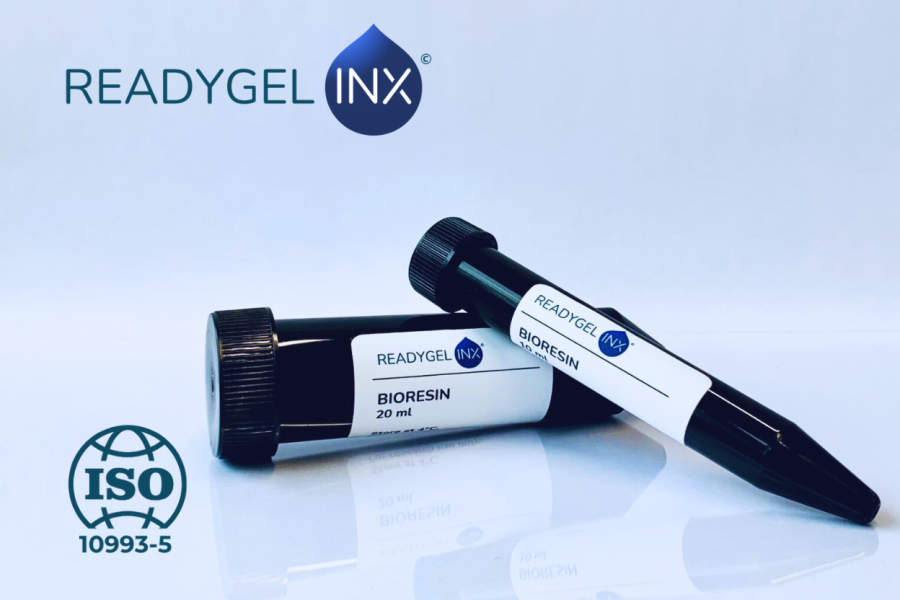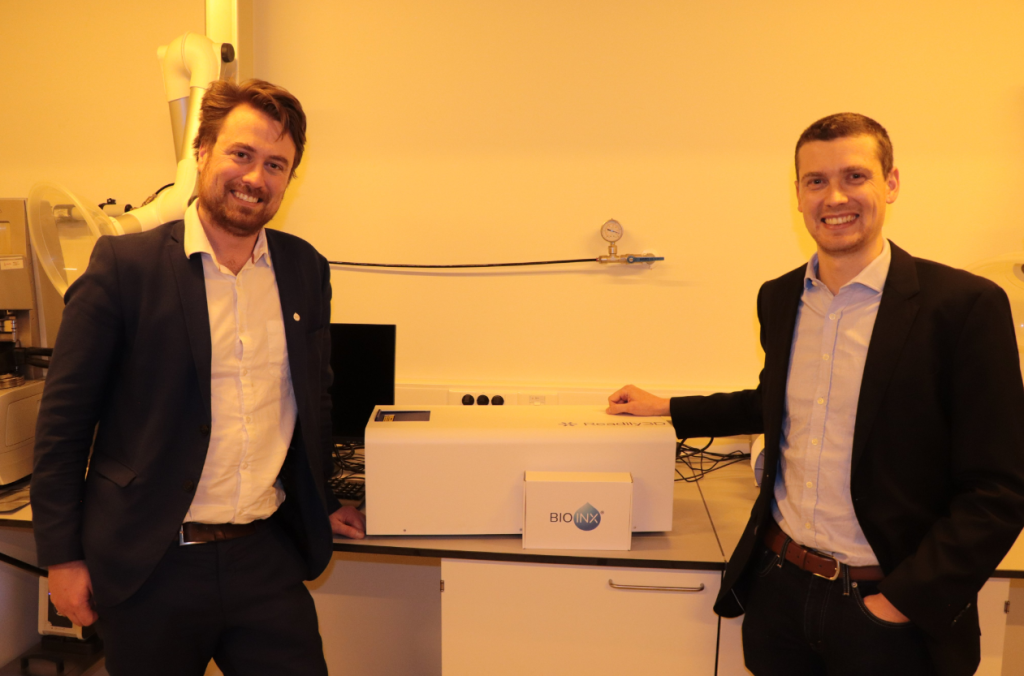Bioink technologies firm BIO INX has partnered with high-resolution volumetric 3D printer manufacturer Readily3D to introduce innovative biomaterials for volumetric 3D bioprinting.
Sterile and ready to use, this collaboration’s first commercially available bioink, READYGEL INX, is a novel gel-MA-based ink designed for high reproducibility and exceptional performance in volumetric bioprinting applications. Designed for user convenience, READYGEL INX adheres to BIO INX’s “plug and print” principle, featuring pre-optimized processing parameters to simplify the bioprinting process and improve usability for researchers.
“Thanks to the speed of this technology, with the newly developed highly biocompatible resin, the futuristic idea of harvesting cells, printing directly alongside the patient in the operating room prior to reimplantation becomes an attainable reality,” says Coralie Gréant, COO at BIO INX.

BIO INX’s medical expertise
As per BIO INX, using tomographic 3D printing technology, researchers can solidify photosensitive inks in three dimensions by directing shaped light beams from various angles. This approach rapidly produces centimeter-scale biological systems with microscale resolution within seconds. By employing a low light dose (<600 mJ/cm²), this method minimizes shear stress on printed cells, making it particularly suitable for creating cell- and organoid-friendly structures.
The debut of READYGEL INX coincides with BIO INX’s inception as a spin-off from the research group that initially published Gel-MA in 2000. Led by Prof. Sandra Van Vlierberghe, who co-founded BIO INX, this group boasts extensive experience in gelatin. BIO INX’s recent collaboration with Rousselot to distribute GMP-ready X-pure gelatins further underscores its expertise in the field, says the company.
Paul Delrot, CEO of Readily3D, added, “Partnering with a reputable supplier of reproducible light-based bioinks aligns with our commitment to delivering comprehensive solutions to our customers. By combining materials with high-reproducibility and high-performance systems, we are accelerating the journey towards clinical applications of bioprinting.”
According to BIO INX, READYGEL INX is set to debut at the World Biomaterials Conference (WBC) in Daegu, Korea, scheduled from May 26th to 31st, 2024. Interested parties can purchase it through the BIO INX webshop and Readily3D.

In September of last year, BIO INX contributed to the AstroCardia project by providing the specialized bioink necessary for 3D bioprinting miniaturized human heart models and an artificial circulatory system.
AstroCardia is a collaborative initiative involving five Belgian companies and research centers, aiming to send these 3D printed models to the International Space Station (ISS) in 2025 to study the heart’s accelerated aging process in space. BIO INX’s bioink, which includes biomaterials and stem cells, is essential for creating functional heart organoids, making its expertise crucial for advancing the understanding of cardiovascular diseases and developing new treatments.
Volumetric bioprinting advances
Volumetric bioprinting is an advanced method that uses light to solidify biomaterials within a photosensitive hydrogel, enabling the simultaneous creation of complex tissue structures. It promises faster and more precise fabrication compared to traditional layer-by-layer techniques, potentially revolutionizing fields like tissue engineering and regenerative medicine.
Researchers from Utrecht University developed an ultrafast volumetric bioprinting method to create functional liver units. The team utilized visible light tomography to make stem cells “transparent,” preserving their resolution and biological activity. These liver units were printed in under 20 seconds and exhibited toxin elimination capabilities similar to natural livers, suggesting advancements in regenerative medicine and drug testing.
Overcoming issues of light scattering using iodixanol, a medical contrast agent, allowed for precise printing of densely packed cells. This achievement highlights the application of bioprinting for creating complex tissue structures, crucial for studying liver diseases and therapeutic development.
In 2023, UMC Utrecht researchers conducted volumetric bioprinting by achieving three breakthroughs: creating biologically functional regions within 3D printed cells, optimizing cell survival using granular gels, and integrating volumetric bioprinting with melt electrowriting to strengthen 3D printed blood vessels. According to the team, these innovations aim to enhance the clinical utility of 3D bioprinting by enabling precise control over cellular interactions and tissue formation, potentially paving the way for biofabricated scaffolds that guide cell development and complex organ structures suitable for medical applications.
Join the Expert Committee for the 2024 3D Printing Industry Awards to help select the winners!
What 3D printing trends do the industry leaders anticipate this year?
What does the Future of 3D printing hold for the next 10 years?
To stay up to date with the latest 3D printing news, don’t forget to subscribe to the 3D Printing Industry newsletter or follow us on Twitter, or like our page on Facebook.
While you’re here, why not subscribe to our Youtube channel? Featuring discussion, debriefs, video shorts, and webinar replays.
Featured image shows BIO INX and Readily3D’s company representative. Photo via BIO INX.


